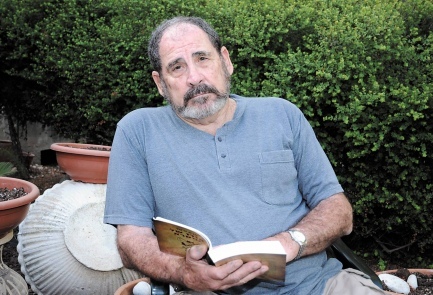
THINK-ISRAEL |
In the place where Jewish tribes became a nation about 3,200 years ago, time has stopped — Professor Adam Zertal, the archaeologist who conducted excavations on Mt. Ebal, has amassed surprising evidence at a cost to his career — "If you support a revolutionary idea, you are severing your ties with certain power players — Joshua's altar: the discovery that can't seem to overcome political obstacles.

On the summit of the mountain, between Joshua’s altar and the spectacular view, a Canadian tourist approached and asked Professor Adam Zertal a question. Why, in light of these amazing findings, which no one has contradicted but many, many people continue to ignore, does the Israeli education system not make this site into a permanent location for studying Israel’s beginnings as a nation? Zertal looked at him with a serene smile that nevertheless betrayed inner struggle and answered, “That’s a good question. Go ask Bibi. Go ask [Education Minister] Gideon Saar.”
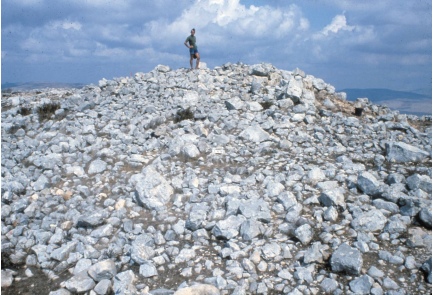
Indeed, 27 years since the sensational discovery of “Joshua’s altar” and approximately 20 years after it was made public, the world's most important Biblical archaeological site still lies shrouded in darkness. How many Israelis know about it? How many of them have visited it? This site is the Holy Grail of Biblical archaeology, the most significant site to be discovered in centuries. But it is significant not only scientifically and archaeologically. Rather, Zertal claims and proves through his knowledge that in that place, we became a nation 3,200 years ago, shortly after the Israelite tribes entered Canaan.
And Moses and the elders of Israel commanded the people, saying: Observe all of the commandments that I command you this day. And it will be, on the day that you cross the Jordan to the land the Lord, your God, is giving you, that you shall set up for yourself huge stones, and plaster them with lime. When you cross, you shall write upon them all the words of this Torah, in order that you may come to the land which the Lord, your God, is giving you, a land flowing with milk and honey, as the Lord, God of your forefathers, has spoken to you. And it will be, when you cross the Jordan, that you shall set up these stones, regarding which I command you this day on Mount Ebal, and you shall plaster them with lime. And there, you shall build an altar to the Lord, your God, an altar of stones. You shall not wield any iron upon them. You shall build the altar of the Lord, your God, out of whole stones. And on it, you shall offer up burnt offerings to the Lord, your God. And you shall slaughter peace offerings, and you shall eat there, and you shall rejoice before the Lord, your God. You shall write upon the stones all the words of this Torah, very clearly.” Moses and the Levitic priests spoke to all Israel, saying, “Pay attention and listen, O Israel! This day, you have become a people to the Lord, your God. You shall therefore obey the Lord, your God, and fulfill His commandments and His statutes, which I command you this day.” [Deuteronomy 27:1–10]
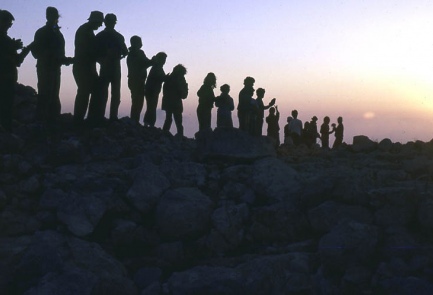
AS WE ENTER THE VALLEY on the eastern ridge of Mount Ebal, 800 meters above sea level, the spectacular view of north and east Samaria spreads out before us. To the east lies Mount Kabir, upon which the community of Elon Moreh is located; farther down is the Michmetath Valley, the biblical boundary between the tribes of Manasseh and Ephraim (Joshua 16-17). On the opposite ridge is a hill that resembles Masada – this is Hirbet el-Ureima, also known as Arumah, the capital of King Abimelech (Judges 9). At the foot of Mount Kabir is the wide valley of Nahal Tirza (Wadi Far’a), which is “the way of the going down of the sun” (Deuteronomy 11, 29-30) that leads from the Jordan River to Mount Ebal. The area abounds with places mentioned in the Bible: the Tubas Valley is Thebez (Judges 9), Mount Bezek (Judges 1), and so on. We're on top of the world.
And where is Shechem (modern-day Nablus)? South of Ebal. It is not visible from here, but it is present all the time – Biblically, archaeologically, politically and militarily. The site’s location on the eastern side of the mountain is no coincidence. It is connected to the manner in which the Israelite tribes arrived after crossing the Jordan, along Nahal Tirza (on the road which leads west) to Ebal.
We do not know the location of Mount Sinai and even Jerusalem has changed in appearance in the thousands of years that have passed. Here, on Mount Ebal, history has frozen in place. Everything remains as it was 3200 years ago, waiting for the descendants of the original people who built the altar. If this is the place where we became a nation, this has implications both for the structure and for the site as a whole. Zertal’s findings allow us to reconstruct much of the ceremony during which our nation was established.
“We excavated here for approximately ten years,” says Zertal. “I realized that nothing here was done by accident. A great deal of thought went into the location, construction and the rest of the details.” The biblical injunction was to construct an altar “at Mount Ebal,” not “on top of” it or “at the foot” of the mountain. Accordingly, the altar is located on the third step (approximately 800 meters above sea level) from the summit (940 meters). It was located at the corner of a very large valley, a kind of natural amphitheater that could hold a large crowd, more than tens of thousands of people. This is an important point because the ceremony on Mount Ebal was “direct democracy” – everybody was there: “All the congregation of Israel, with the women, and the little ones, and the strangers that walked among them.”
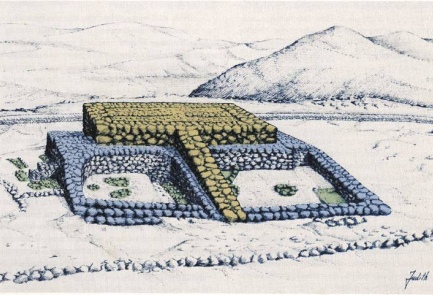
Then Joshua built an altar to the Lord God of Israel on Mount Ebal. As Moses, the servant of the Lord, commanded the children of Israel, as it is written in the book of the law of Moses, an altar of whole stones, upon which no (man) has lifted up any iron. And they offered upon it burnt-offerings to the Lord and sacrificed peace-offerings. And he wrote there upon the stones a copy of the law of Moses, which he wrote in the presence of the children of Israel. And all Israel, and their elders and officers and their judges, stood on this side of the Ark and on that side, before the priests the Levites, the bearers of the Ark of the covenant of the Lord, the stranger as well as the native born, half of them over against Mount Gerizim and half of them over against Mount Ebal, as Moses the servant of the Lord had commanded, to bless the people of Israel first. And afterward he read all the words of the law, the blessing and the curse, according to all that is written in the book of the Torah. There was not a word of all that Moses commanded, which Joshua did not read before all the congregation of Israel, with the women, and the little ones, and the strangers that walked among them. [Joshua 8:30–35]
The performance of the ceremony in the book of Joshua differs somewhat from the instructions that were given in the book of Deuteronomy. For various reasons, the student (Joshua) deviated from the instructions of his teacher (Moses). The people were divided into two in the valley – half of them looked westward toward the summit of Mount Ebal, while the other looked eastward, toward the summit of Mount Kabir, which, according to Zertal, is the biblical Mount Gerizim. In any case, it is likely that those in attendance were careful not to turn their backs on the Ark of the Covenant, which, according to scripture, stood beside the altar.
Another aspect that is important to the ceremony is acoustics. The valley is laid out in such a way that speakers near the altar are audible from everywhere in the valley. We stood approximately 600 meters away from the altar and two soldiers ascended it and called out: “Am Yisrael hai” (long live Israel). Despite the airplanes up above, the murmuring of the group and the ringing of the cellphones, we heard it very well.
ZERTAL SAYS, “IN RECENT DECADES, during which the debate over the Bible’s historical accuracy has broken out with even greater vigor, I can say with absolute certainty that going out in the field, the archaeological survey that we have been conducting over the past 34 years and the excavations have revealed that the vast majority of the historical data that appear in the Bible about the beginnings of the Israelite nation are accurate.” Of course, this poses quite a dilemma for academia in Israel and the world. Zertal says that he is a researcher first of all, and what interests him is the scientific and historical truth. He says that as a kibbutznik from Ein Shemer, he did not receive a religious education. The Bible was not seen as a history book.
“Our basic assumption from the beginning was that there was no altar. The whole thing was considered nonexistent. In most history books, we find that the whole story in Deuteronomy and Joshua is a myth, a later invention whose purpose was to create history. You’ll find the same opinion regarding the exodus from Egypt. It’s almost Passover. You should know that according to the view of many professors, we never went out of Egypt.” He quotes the archaeologist Ze’ev Herzog of Tel Aviv University, who says that it is “obvious today” to researchers that we were never in Egypt, we never left Egypt, we were never in Sinai, we never entered the Land of Israel and monotheism was created at the end of the monarchy, close to the destruction of Jerusalem, many centuries after the Bible says it was. Zertal had shared these opinions to a large extent until, by trial and error, surveys on foot lasting many years and excavations, he reached the conclusions that he holds today with great confidence. One might say that the discovery sent his previous world into a crisis that eventually bore fruit.
WHEN WE LOOK AT THE AREA, we see that it is strewn with stones. When Zertal and his team came here for the first time, the site was covered with a layer of stones, and in the location of the altar was a pile of stones that measured approximately thirty by thirty meters and was four meters high. When excavations started and the discoveries mounted, they realized that the pile of stones had served to hide the site. It had been hidden away (Geniza). The purpose of doing so was to prevent desecration. In Jewish tradition, a human being who has died is hidden away by burial. A Torah scroll is hidden away (so, by extension, are all sacred works), as are sacred objects that are no longer fit for use – so a holy place that had been abandoned, such as the altar, was hidden away as well. The site was hidden away when the Israelites left the area. They moved 40 kilometers southward to Shiloh, which served as the capital of the Israelite tribes during the period preceding the monarchy. From there, they moved approximately another 40 kilometers southward to Jerusalem, which remains the national and religious capital to this very day. It appears that the wanderings did not cease with entry into the land, but lasted for approximately another two hundred years – from Manasseh and Ephraim to Judah – until we reached our final settlement pattern.
Right in the beginning of the excavations, they realized that the site had not been settled permanently. The area contained no houses or streets – only one odd structure. Zertal reiterates that he came with no preconceived notions. In addition, because of his upbringing and academic views regarding the Bible, the thought of an altar never occurred to him. The solution was born out of years of hard work. A large quantity of pottery was amassed, almost all of it from the early Iron Age – the period during which the Israelite tribes settled in Canaan, from the thirteenth to the eleventh centuries B.C.E.
Pottery vessels are found where people lived. The number of people who were here can be determined by the massive quantity of pottery shards found throughout the valley. The Israelites who came on pilgrimage had to eat and drink throughout the days (or weeks) of the ceremony. For that purpose, they brought vessels whose shards were found. Early Israelite pottery, which is fairly coarse, contains crushed stone grits. It is not refined or delicate. The technique was not sophisticated. There are no dwellings, but there are thousands of pottery shards, which shows that people stayed here briefly in order to attend the ceremony.
ONE OF THE PEOPLE ON THE TOUR ASKS whether there are researchers – colleagues – who support him. Zertal names the late Professor Benjamin Mazar, who “supported me to an extent, but it was difficult for him because he was part of the mainstream. If you support a revolutionary idea, you pretty much cut off your relationships with certain people in positions of power.” Once again, he quotes Professor Lawrence Steiger of the Harvard Museum of Semitic Studies who said at the end of the 1980s: “If the ruin on Mount Ebal is what Adam Zertal says it is, the effect on archaeology and Biblical studies will be revolutionary; we will all have to go back to kindergarten. But that’s a big if.”
He mentions scientists whose revolutionary ideas met with vigorous rejection by the contemporary establishment, which ostracized them, from Galileo to Daniel Schechtman. “Put yourself in the shoes of professors who wrote books for decades, and suddenly along comes some pipsqueak from the Ha-Shomer Ha-Tza’ir movement who discovers an altar that matches, point for point, what is written in the Bible. What would you do? Ze’ev Herzog writes an article entitled ‘The Bible – No Findings on the Ground.’ An entire career was built on the theory of ‘no data.’ And suddenly there are facts! Incidentally, an American researcher by the name of William Dever says that there were only ‘proto-Israelites’ here. It’s not really clear what that means. But we found 420 Israelite sites from the settlement period (the Iron Age I period).”
“Now, if you disagree, go ahead and write a paper that refutes my findings. Nobody has done that yet. On the other hand, if you agree, you risk the collapse of your scientific career. In the 1960s, Thomas Kuhn published his book, "The Structure of Scientific Revolutions." All science is connected to theory. Fact itself has no meaning unless it is part of a theory. There are two conditions of the validity of a scientific theory. The first is that most of the data fit it, and the second is that no better theory exists – in other words, a theory that has more data that support it. That is my situation – the vast majority of the data fit the theory, and no one has suggested an alternative theory. In the case of Galileo, instead of an alternative theory, the Inquisition put him in a cell. Today, there is no religious Inquisition, but the tactic is still in use.”
The Inquisition has accompanied Zertal since he first made his discovery because of its location in the heart of Samaria. He has not been persecuted by academia alone. In May 1986, journalist Nahum Barnea published an article against Zertal's discovery in his weekly magazine, Koteret Rashit (Banner Headline). Even then, Barnea specialized in labeling as “dangerous” any person or occurrence that did not accord with his political world view. He titled his essay “The Sacrifice and the Profit” and added a subheading, “There have always been archaeologists who agreed to serve as fig leaves for any time just as long as they can keep on digging. That is how they abetted all the thefts of Moshe Dayan. That is how they abetted a series of settlement activities in the territories, from Shiloh to Tel Rumeida. Now there is an archaeologist excavating an altar on Mount Ebal, opposite Nablus, for Gush Emunim. Where did this archaeologist come from? He came out of the pages of The Seventh Day” [in Hebrew “Si’ach Lochamim” - a book of interviews of soldiers who fought in the Six Day War, edited by Avraham Shapira and Amos Oz]."
You can be sure that Barnea knew nothing about the discovery or the abundant archaeological data – just like the archaeologist Aharon Kempinski, who took a single hour during the first digging season (out of ten!) to dismiss the discovery, claiming that the altar had actually been a guard tower. Zertal refuted his claim easily because Kempinski was completely unfamiliar with the site and paid no attention to his many findings. While Kempinsky was on Mount Ebal, he looked over the landscape of Samaria, spread out his hands and said, “How beautiful you are, Palestine.”
AND THEN THE EXCAVATIONS BEGAN. An Egyptian scarab seal was found toward the beginning. It was a big surprise. It was a seal of Raamses II, who is considered the Pharaoh of the exodus from Egypt. Afterward, another one was unearthed. Both were from the last third of his era, between 1250 and 1220 B.C.E. Few scarabs of that type have been found in the region – only at the altar, which had been sealed off from outside interference (a sealed locus) since the time it was hidden away. Could that be a souvenir of the place from which those wanderers had come to the mountain for the ceremony that established them as a nation? Incidentally, the son of Raamses II, Merneptah, went to Canaan around 1208 B.C.E., and on his obelisk recounted, among other things, that in Canaan, he met tribes by the name of “Israel.”
When the outer layer of stone was removed, a structure, or bamah, measuring nine meters by seven meters and four meters high, was uncovered. Its original height is known because the other side was completely preserved. The upper part of the structure was found paved, and on its three lower sides there was a terrace that jutted out approximately two meters. The structure was not filled by stones, but hollow (“hollow with planks”; Exodus 27:8), and at its center were two separate walls. When the upper layer was removed, a big surprise awaited the excavators: a layer of pure ash approximately a meter and a half thick that contained approximately a thousand animal bones, all scorched by fire.
When people eat a cooked meal, the bones are not scorched. Only when they are completely burned as offerings does the fire reach the bones. The bones were sent to Jerusalem that very evening, to the zooarchaeologist Liora Horwitz. Her answer was quick in coming. She said that she had never seen such a special collection of bones. All of them belonged to male yearling animals of four groups: goats, sheep, cattle and fallow deer. The first three are sacrificial animals mentioned at the beginning of Leviticus. At other sites, the bones of horses, donkeys, dogs and so on are usually found. Here were only sacrificial animals. As for the fallow deer – that beautiful red-furred creature – it was a kosher animal (Deuteronomy 14). Apparently, this was the beginning of the development of the sacrificial culture, when game animals were still permitted as sacrificial offerings.
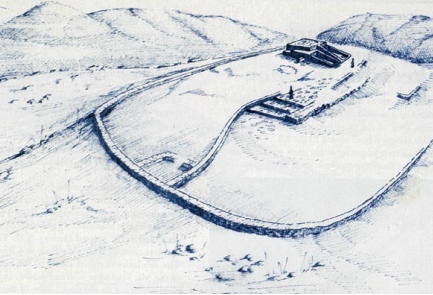
No animals but those four kinds were found. As stated, in 1200 B.C.E., animals were used as sacrifices in accordance with the laws of the Torah. If the researchers say that the laws of sacrifice and kashrut were created only approximately six hundred years later, how can these findings be explained? Carbon-14 dating also indicated, with rare precision, the year 1200 B.C.E.
At this stage, there were many findings, but they had not been connected to any comprehensive explanation. The forward portion of the structure provided part of the final answer. A double ramp ascends the bamah. The main ramp reaches the top of the bamah, while the secondary ramp reaches the terraces. When we read the description of the altar of the Second Temple in Tractate Middot of the Mishnah (third chapter), we get an amazingly similar description of the altar on Mount Ebal, which preceded the one mentioned in the Mishnah by approximately 1200 years. The priest used the main ramp to bring the offering to the fire at the center of the altar. Afterward, he ascended the secondary ramp to the surrounding area (the “terraces”) in order to continue the sacrificial service (sprinkling the blood and so on). The ramp itself was built because of the biblical prohibition against using stairs in the construction of an altar. The shape of the altar in the Second Temple proves that the altar on Mount Ebal is the original Israelite sacrificial altar, an archetype of the altars that came after. This is a fairly rare occurrence in archaeology: the altars of the First and Second Temples have not survived, but the original one has been found, and with it a whole world has been revealed – a greeting from our ancient forebears.
IN ADDITION TO THE ANCIENT LANDSCAPE that surrounded us on all sides and the history that burned beneath our feet, a patrol of F-16 and F-15 fighter jets flew overhead the entire time. Aircraft identification is not my strong suit, but there were high-ranking officers around me from all branches of the military for whom this is their bread and butter. The symbolism was sharp: a flyover of homage from the modern Hebrew military to the ancient Hebrew general, Joshua son of Nun, who built an altar here and conducted the seminal ceremony that established us as a nation upon this good land.
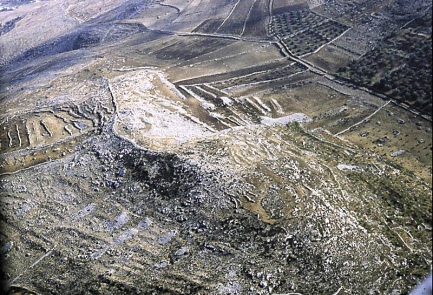
Dror Eydar, Ph.D., is an analyst and writer for Israel Hayom
This article appeared April 12, 2012 in Israel Hayom
(http://www.israelhayom.com/site/newsletter_article.php?id=3848).
Thanks are due Paul Rotenberg for send this article to Think-Israel.
Rotenberg writes,
"The unfortunate subtext, for 27 years various Israel governments have not wanted to recognize another strong link to Yehuda and Shomron."
Editor's Addendum:
I first heard of Adam Zertal and the Altar when I visited Elon Moreh during a tour conducted by AFSI in November 2002 ("The Settlements Revisited", http://www.think-israel.org/afsitrip.html). Zev Safer and Pincus Fuchs of Elon Moreh noted that we Jews have title deeds recorded in the Torah: to the Ma'arat Machepelah, where Abraham and Sarah are buried; to the Temple Mount area in Jerusalem; and to the area in Shechem where Joseph's Tomb is located. It would seem the Arabs take our history seriously -- they fight to take over these places, places where Judaism took root.This is what I wrote:
"We drive to the town of Elon Moreh, which sits near both Mt. Grizim and Mt. Ebal in the Eastern part of Samaria. It was founded in 1975, the first in the Shomrom, as close as the settlers could come to the original site. It is now a town of some 200 families, with schools from preschool on up to the Yeshiva Birkat Yosef, where they educate their children and children from neighboring Itamar, Yitzhar and Bracha."While we eat lunch, Rav Menachem Felix greets us and points out that you can see most of Israel from Mt Grizim. He reminds us that when Abraham came into the Land of Israel some four thousand years ago, he came to Shechem, to Elon Moreh. This is where he built his first altar. This is where his descendants, we Jews, were promised the Land. Jacob bought land here, and it became his son Joseph's burial place. The Romans renamed the town Neapolis (New Town) and the name degenerated to Nablus, which is what the Arabs call it.
"I remember coming to Nablus in 1968, not long after Israel had captured it. We visited Joseph's Tomb. We bought rather smelly sheepskins in the marketplace. We walked around freely. The Oslo War changed all that. The Arabs destroyed the Tomb in 2000, ripping hundreds of prayer books, setting fires and using crowbars to break through the stone dome of the tomb. And the residents of Elon Moreh suffer terribly from attacks coming from Shehem. As I write this account in the middle of November, the terrorists have struck again, throwing explosives at motorists passing by Elon Moreh.
"Zev Safer and Pincus Fuchs spoke of the history of Elon Moreh. There are three pieces of land to which we have deeds that are written about in the Torah: Abraham bought the Ma'arat Machepelah (the Tomb of the Patriarchs) in Hebron to bury Sarah, David bought the area of Har HaBayit (the Temple Mount) in Jerusalem, and Jacob bought a field here in Shechem (the Tomb of Joseph). 'It is these areas the Arabs fight the most to take over. Perhaps," Safer speculated, "because they know these are our roots. After the long journey from Egypt and after crossing the Jordon and coming into Jericho, on the same day, the Jews came here to Mt. Grizim and Mt. Ebal. This is where they became a nation, because this is where they acquired land.'
"Some years ago, an archeologist, Adam Zertal, saw a pile of stones on Mt. Ebal, and found what he thought was a house, with ashes in the middle. It proved to be an altar, and was dubbed Joshua's altar by its discoverer. Although it is 1000 years older, it is structured exactly like the Second Temple in Jerusalem, as described in the Mishnah, Tractate Middot. Zertal writes: "The altar there is an archetype of all later sacrificial altars, and it furnishes incontrovertible proof of religious and national consolidation at so early an era." (c.f., adam zertal, http://www.shechem.org/machon/engevala.html)
"In the middle of the altar, he found a scarab seal that may have been owned by someone who'd left Egypt with it, had it at Mt Sinai, had listened to the giving of the Torah, had come to Shechem and lost it here. (Only five scarabs like this one exist: one is from Egypt, three are from Israel and one is from Cyprus.) It transformed his life; he'd started as a radical secularist from Hashomar Hatzair. "